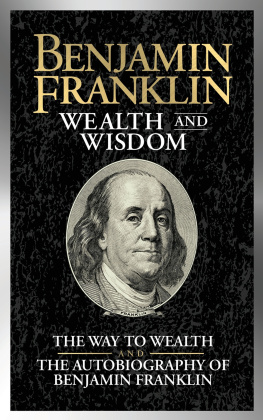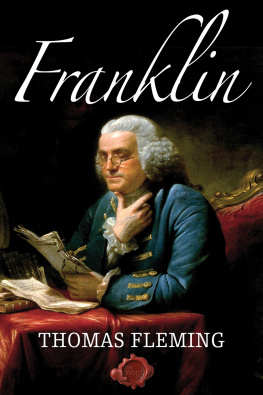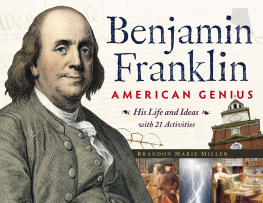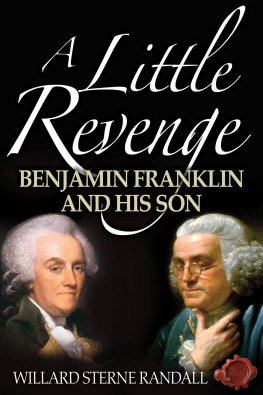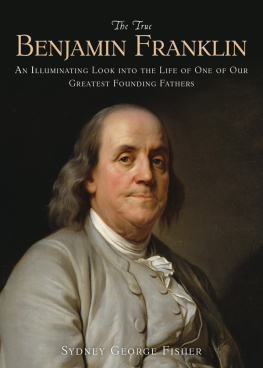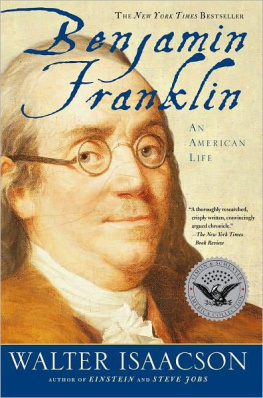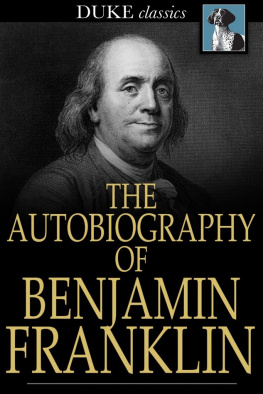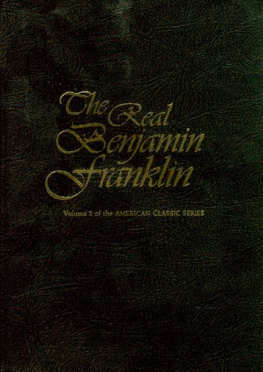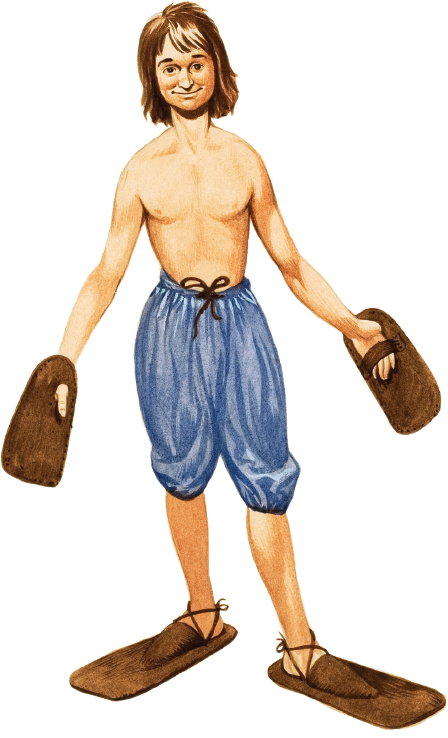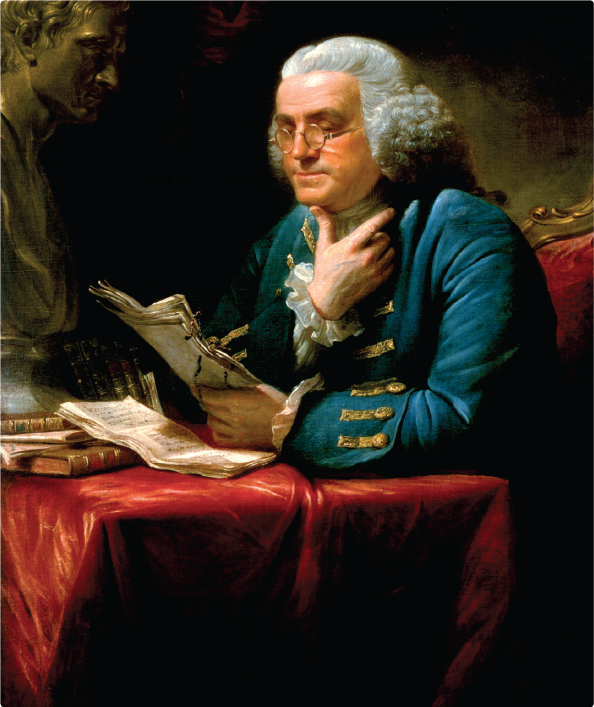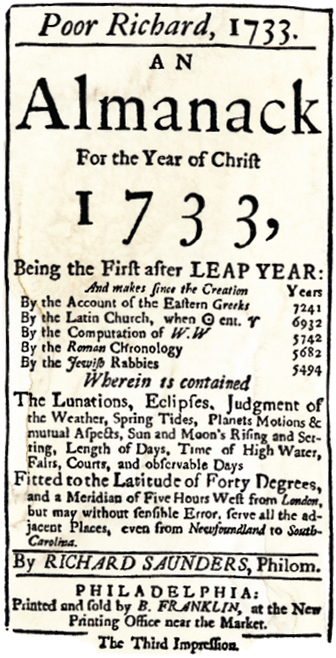CHAPTER ONE
A BUSY LIFE
Benjamin Franklin lived to a ripe old age, but even so, his list of accomplishmentsseems too long for one lifetime. He was a man of many talents, a jack-of-all-trades.Today people remember him as an author, printer, inventor, and scientist. Really,what couldnt the guy do? And when he wasnt busy writing and inventing, he lenthis wisdom to the founding of the United States. His role among the founding fatherswas so important that his picture is on our $100 bills.
Just who was Ben Franklin? He was born in Boston, Massachusetts Colony, in 1706.His father was a candle maker and a soap maker. As a teenager, Franklin went to Philadelphiato make a living as a printer. He eventually started his own printing business. Onhis press, Franklin printed books and pamphlets, and he became an author himself.
Franklin was interested in science and how things worked. He invented many itemsfor daily use. His interest in electricity, as well as weather, led to his famouskite-lightning experiment. Before the Revolutionary War, he served as an agent toGreat Britain, trying to maintain and repair the relationship between Great Britainand the American colonies. Eventually he became a signer of the Declaration of Independence,and he later helped craft the U.S. Constitution. His contributions to the UnitedStates earned him a prominent place as a founding father.
AN INVENTIVE MIND
In his time, Franklins inventions helped make his name known to many in the Americancolonies. Often these inventions grew out of his daily needs and wishes. Swim fins,for example, were one of Franklins first inventions. He came up with the idea ofswim fins when he was about 11 years old. These devices were meant to help him swimfaster. Franklin and his friends often gathered along the banks of the Charles River,where Franklin discovered his love of water. In those days, not many people knewhow to swim. And people rarely swam for fun. But Franklin taught himself to swim,and he helped his friends learn how to swim too. He also often wandered the docks,watching ships sail in and out of Boston Harbor. He fancied becoming a sailor, likehis older brother Josiah Jr. But when Josiah died at sea, Franklins father triedto steer his younger son away from a life at sea. Even so, Franklins love for swimmingnever faded.
When Franklin went swimming, he often thought about ways that he could swim faster.He realized that the size of peoples hands and feet determined how much water theycould push as they swam. If his hands and feet were bigger, he thought, he couldpush more water and propel himself faster in the water. He made two oval wooden paddles,or fins, for his hands. He poked a hole in the fins for his thumbs so he couldhold onto the paddles. He also strapped boards to his feet, which he called flippers.The combination of swim fins for his hands and flippers for his feet helped him tomove faster through the water.
The young Ben Franklin used wood to create devices to speed him along in the water.
His swim fins were not entirely effective, though. His wrists got sore from flappingthe paddles, and the flippers were too stiff to truly mimic a fishs tail. Still,he made the best of the materials he had to work with. And his invention led to modern-dayswimming fins.
SOLVING EVERYDAY PROBLEMS
Franklin was always looking for ways to make daily life easier for his fellow colonists.His inventions were geared toward everyday life. One of these inventions was theFranklin Stove. During the 1700s, fireplaces provided the source of heat for homes.But these fireplaces presented problems. Sometimes houses filled with smoke, andstray sparks from the flames could cause house fires.
In 1742, Franklin aimed to fix the problem with fireplaces and make heating moreefficient. He designed what became known as the Franklin Stove. The Franklin Stovewas a wood-burning stove that could be built into fireplaces. Heat and smoke fromthe fire would rise to warm an iron plate on top of the stove. The smoke was thencarried down a channel under the wall of the hearth, and then up and out the chimney.Drawing cool air from the basement, the stove warmed it in an inner metal chamber.Then the warm air was let out into the room.
Franklin created Double Spectacles with lower portions of the lenses for readingand top portions to clarify things in the distance.
Another of Franklins inventions solved a problem that was with him every minuteof the dayhis faulty vision. Franklin, like many other people, had two pairs ofglasses. One was to see things far awaydistance glasses. The other helped see thingsclose upreading glasses. He found himself often switching between the two and becomingannoyed in the process. What if, he thought, the lenses could be cut in half? Thetop would be for seeing far away, and the bottom would be for reading. In 1784, hehad his eye doctor slice his lenses and place them in one frame. He called them DoubleSpectacles, but they later became known as bifocals. The invention was a success.Millions of people use bifocal lenses or other lenses based on Franklins idea today.
Benjamin Franklin came up with many other useful inventionsan odometer that countedthe rotations of carriage wheels, an extension arm to grab books off high shelves,and a library chair that could also become a step stool, to name a few. But he didntmake much money from his inventions. He didnt believe in patents. A Inother words, he believed that all people benefited by sharing their ideas and inventionsfreely.
THE WEALTH OF POOR RICHARD
An author called Richard Saunders earned Franklin the most money. Who was RichardSaunders? He was actually Benjamin Franklin.
Benjamin Franklin spent part of his youth as an in his brothers printshop, learning to run the printing press and the printing business. He was just ateenager, but he learned the business quickly and became a very skilled printer.As an adult, Franklin owned his own printing press in Philadelphia. He printed manypamphlets and newspapers, including the Philadelphia Gazette, which was one of themost popular newspapers in the colonies. He also printed his own work. Hed alreadybeen writing most of his life, mostly articles filled with humor and wit.
Franklin also printed and sold almanacs. An almanac is a yearly publication thatcontains weather forecasts, horoscopes, witty sayings, poetry, and political andscientific articles. Almanacs were popular for their daily predictions and articles.By printing them, Franklin earned a steady income. But in 1732, he found himselfwithout an almanac to print. The author had moved on to another printer. Franklindecided to write his own.
He made up the fictional character Richard Saunders and his wife, Bridget. UnderSaunderss name and using an invented personality, Franklin wrote an almanac titledPoor Richards Almanack. He printed a supply of copies and offered them for sale.The volume was so popular that Franklin decided to continue. He wrote an annual almanacfor 26 years. By then, the books had made him so much money that he could retire.He was only 42 years old.




